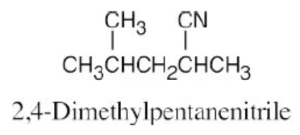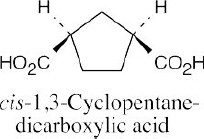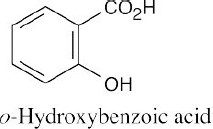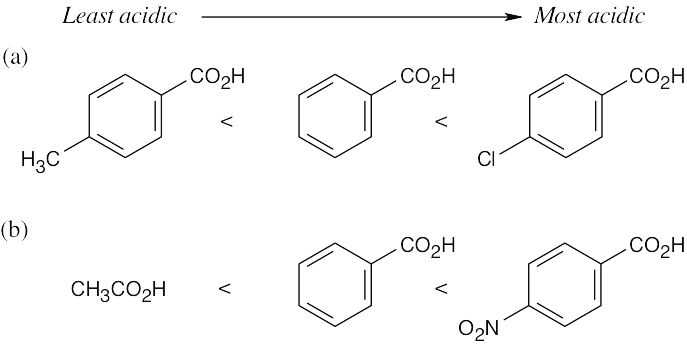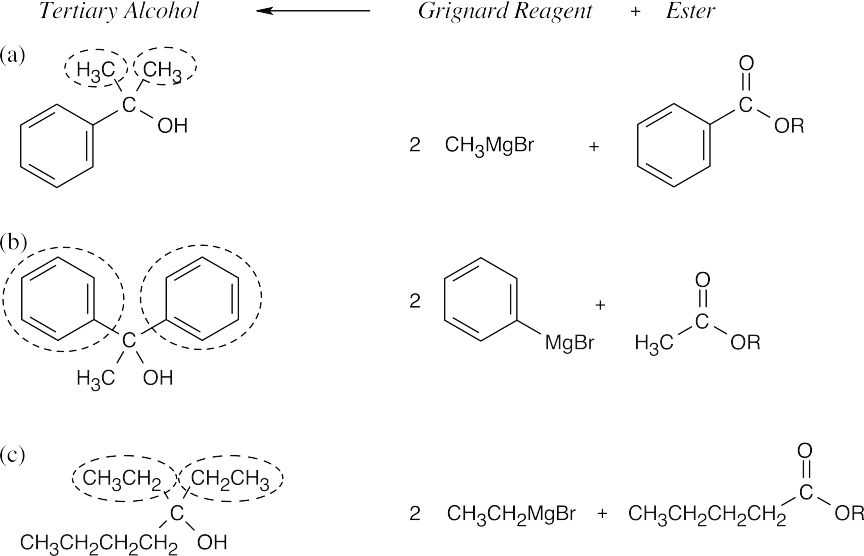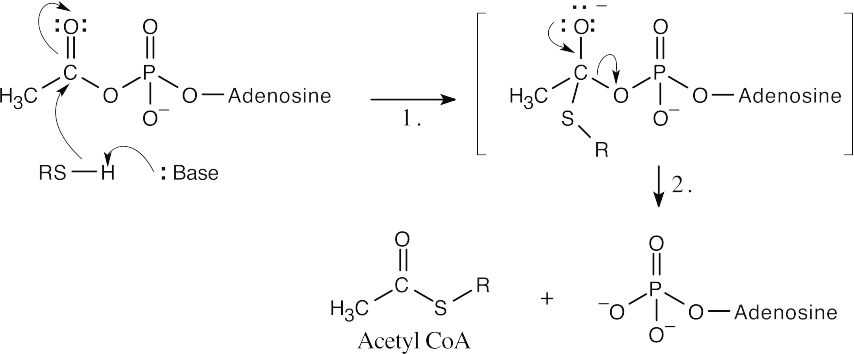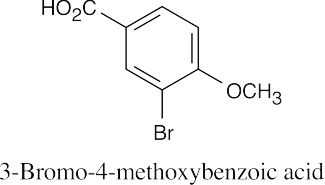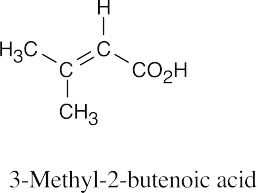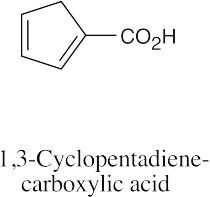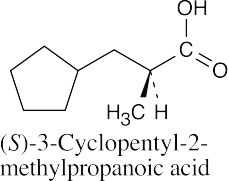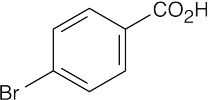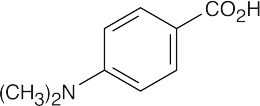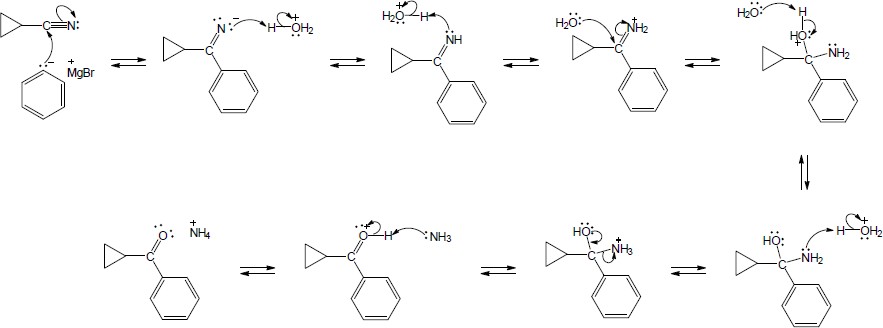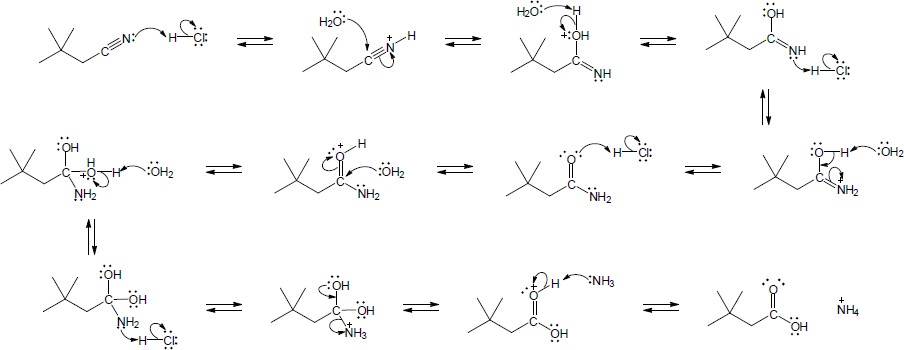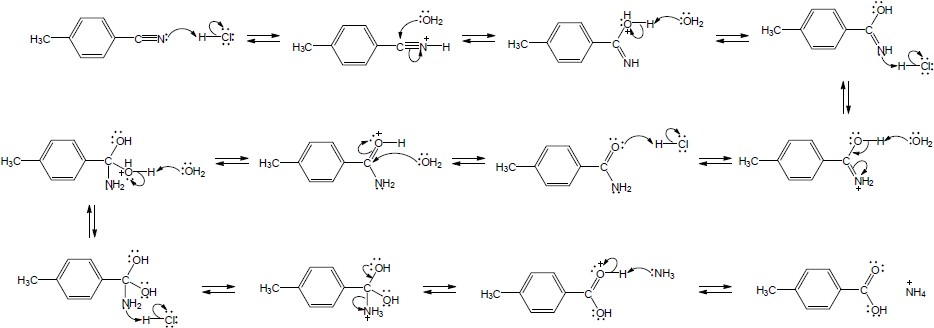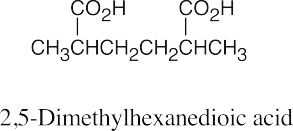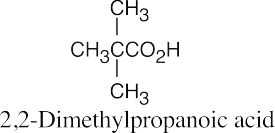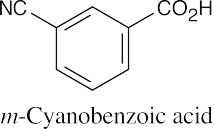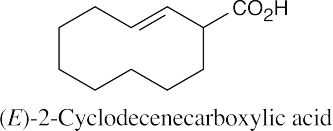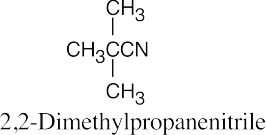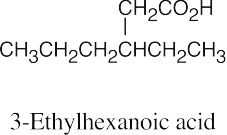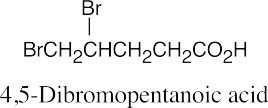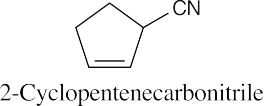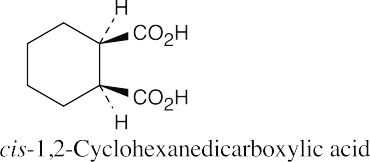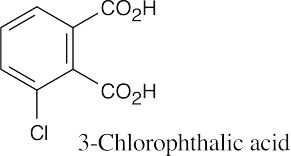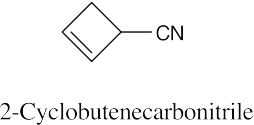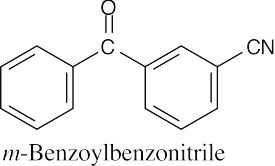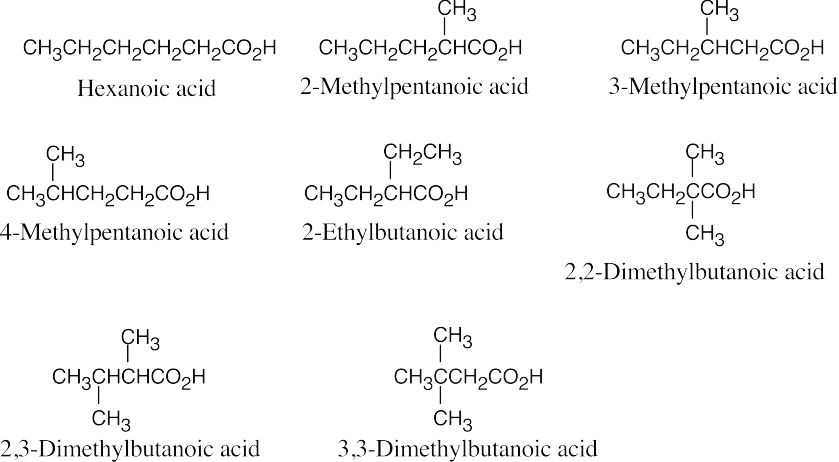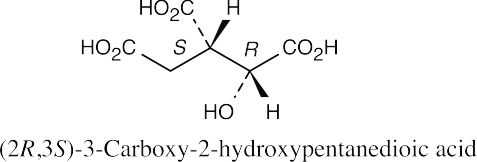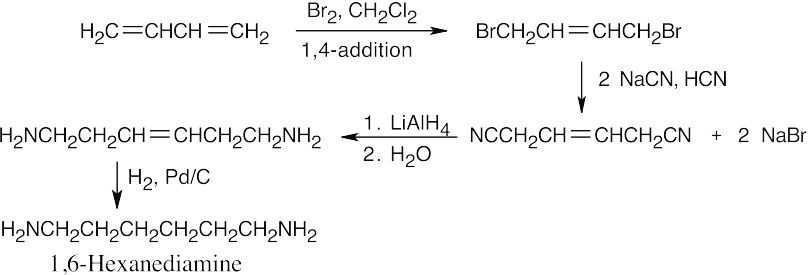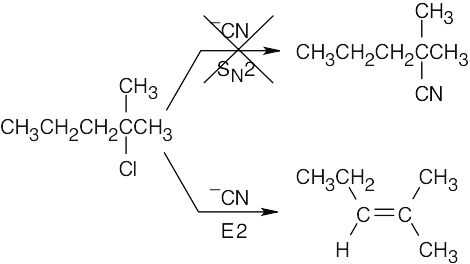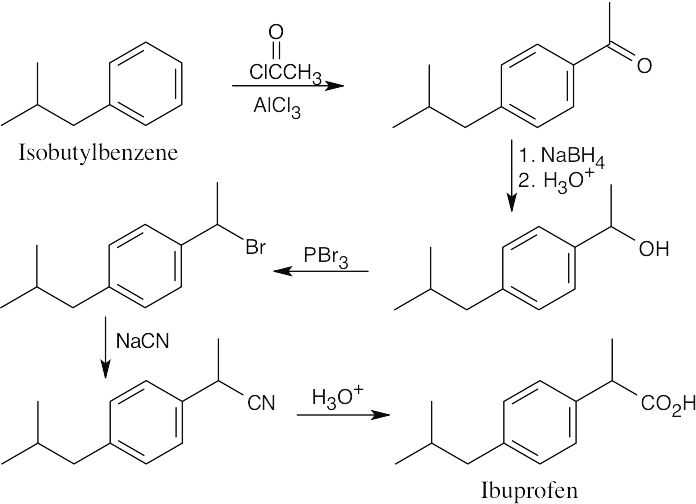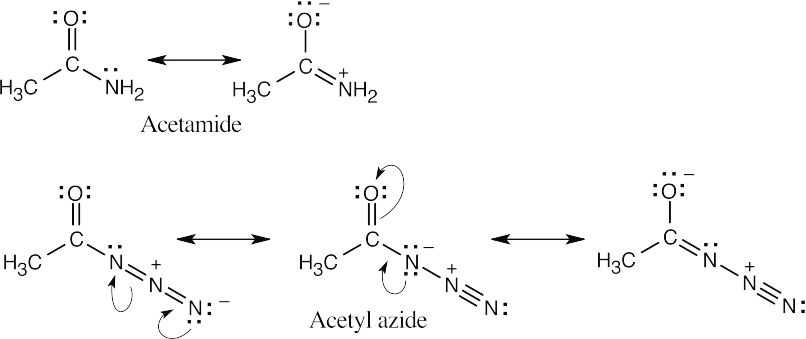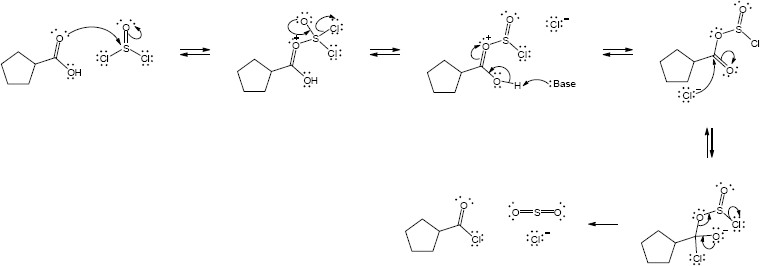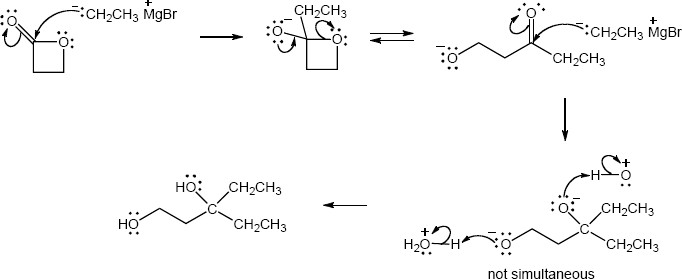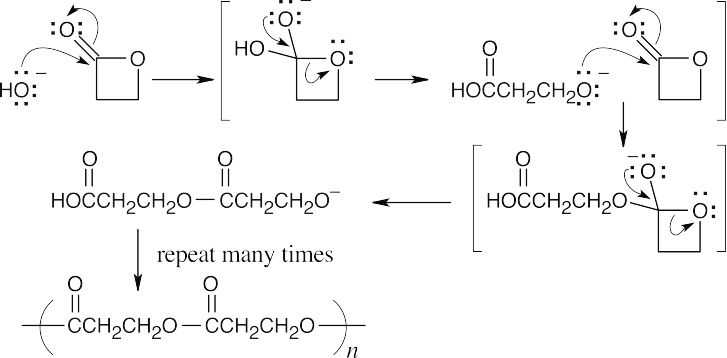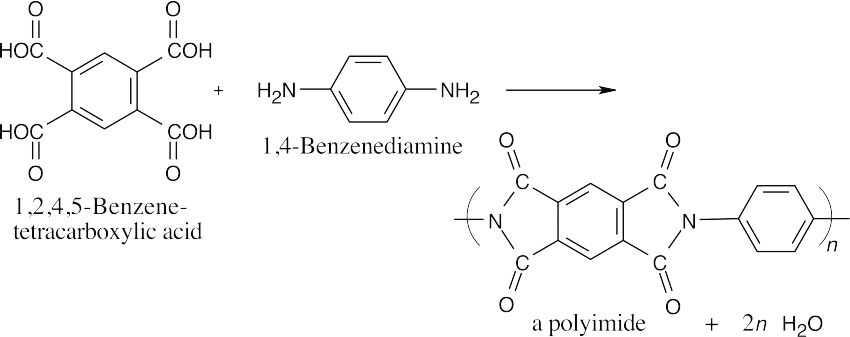11 Chapter 11 Solutions to Problems – Carboxylic Acids and Derivatives: Nucleophilic Acyl Substitution Reactions
Chapter 11 – Carboxylic Acids and Derivatives: Nucleophilic Acyl Substitution Reactions
Solutions to Problems
| 11.1 | Carboxylic acids are named by replacing –e of the corresponding alkane with –oic acid.
The carboxylic acid carbon is C1. When –CO2H is a substituent of a ring, the suffix –carboxylic acid is used; the carboxyl carbon is not numbered in this system.
|
| 11.2 |
|
| 11.3 | Table 11.1 lists the suffixes for naming carboxylic acid derivatives. The suffixes used when the functional group is part of a ring are in parentheses. | |||
| (a) |  |
(b) |  |
|
| (c) |  |
(d) |  |
|
| (e) | 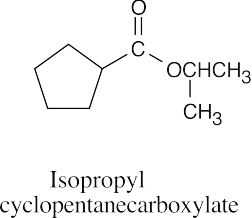 |
(f) |  |
|
| (g) | 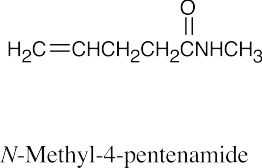 |
(h) | 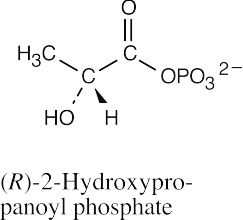 |
|
| (i) | 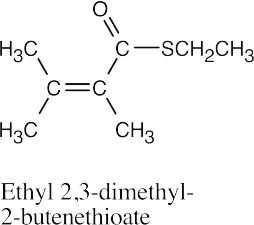 |
|||
| 11.4 | (a) | 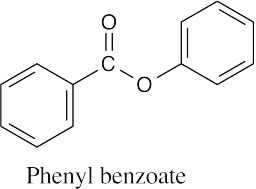 |
(b) | 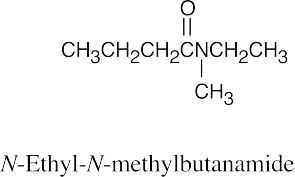 |
| (c) | 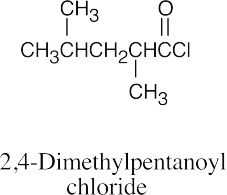 |
(d) | 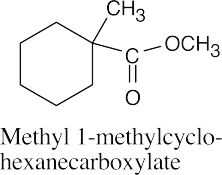 |
|
| (e) |  |
(f) | 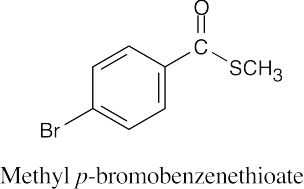 |
|
| (g) | 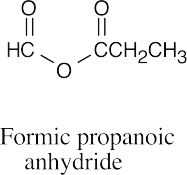 |
(h) | 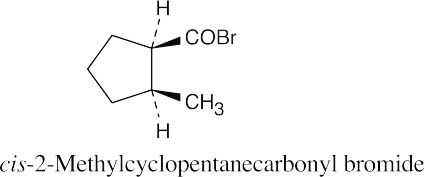 |
| 11.5 | Naphthalene is insoluble in water and benzoic acid is only slightly soluble. The salt of benzoic acid is very soluble in water, however, and we can take advantage of this solubility in separating naphthalene from benzoic acid.
Dissolve the mixture in an organic solvent, and extract with a dilute aqueous solution of sodium hydroxide or sodium bicarbonate, which will neutralize benzoic acid. Naphthalene remains in the organic layer, and all the benzoic acid, now converted to the benzoate salt, is in the aqueous layer. To recover benzoic acid, remove the aqueous layer, acidify it with dilute mineral acid, and extract with an organic solvent. |
| 11.6 | You would expect lactic acid to be a stronger acid because the electron-withdrawing inductive effect of the hydroxyl group can stabilize the lactate anion. |
| 11.7 |
|
| 11.8 | Remember that electron-withdrawing groups increase carboxylic acid acidity, and electron-donating groups decrease carboxylic acid acidity. Benzoic acid is more acidic than acetic acid.
|
| 11.9 |  |
| 11.10 |  |
| 11.11 | Use Figure 11.4 if you need help. | |||
| Most reactive ⎯⎯⎯⎯⎯⎯⎯⎯⎯⎯⎯⎯⎯⎯⎯⎯⎯⎯⎯⎯⎯⎯→ Least reactive | ||||
| (a) |  |
|||
| (b) |  |
|||
| The most reactive acyl derivatives contain strongly electron-withdrawing groups in the part of the structure that is to be the leaving group. | ||||
| 11.12 | Identify the nucleophile (boxed) and the leaving group (circled), and replace the leaving group by the nucleophile in the product. | |||
| (a) |  |
|||
| (b) |  |
|||
| (c) |  |
|||
| (d) |  |
|||
| 11.13 | The structure represents the tetrahedral intermediate in the reaction of methyl cyclopentylacetate with hydroxide, a nucleophile. The products are cyclopentylacetate anion and methanol.
|
| 11.14 | In Fischer esterification, an alcohol undergoes a nucleophilic acyl substitution with a carboxylic acid to yield an ester. The mineral acid catalyst makes the carboxyl group of the acid more electrophilic. Predicting the products is easier if the two reagents are positioned so that the reacting functional groups point towards each other. | |||
| (a) |  |
|||
| (b) |  |
|||
| (c) |  |
|||
| 11.15 | Under Fischer esterification conditions, many hydroxycarboxylic acids can form intramolecular esters (lactones).
|
| 11.16 |
The alcohol product can be formed by reduction of a carboxylic acid with LiAlH4. The carboxylic acid can be synthesized either by Grignard carboxylation or by nitrile hydrolysis. The product can also be formed by a Grignard reaction between benzyl bromide and formaldehyde. |
| 11.17 |
After treating the initial alcohol with PBr3, the same steps as used in the previous problem can be followed. A Grignard reaction between the cycloalkylmagnesium bromide and formaldehyde also yields the desired product. |
| 11.18 | Pyridine neutralizes the HCl byproduct by forming pyridinium chloride. This neutralization removes from the product mixture acid that might cause side reactions. As mentioned previously, positioning the reacting groups so that they face each other makes it easier to predict the products. | |||
| (a) |  |
|||
| (b) |  |
|||
| (c) |  |
|||
| 11.19 | As explained in the text, only simple, low boiling alcohols are convenient to use in the Fischer esterification reaction. Thus, reaction of cyclohexanol with benzoyl chloride is the preferred method for preparing cyclohexyl benzoate.
|
| 11.20 | 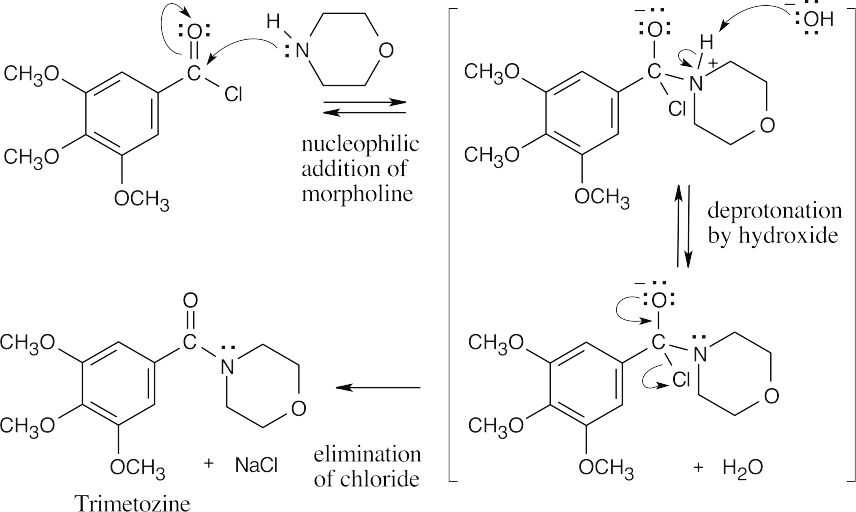 |
| 11.21 | An extra equivalent of base must be added to neutralize the acid produced in these reactions. In (a) and (b), two equivalents of the amine may be used in place of NaOH. | |||
| (a) |  |
|||
| (b) |  |
|||
| (c) |  |
|||
| 11.22 | 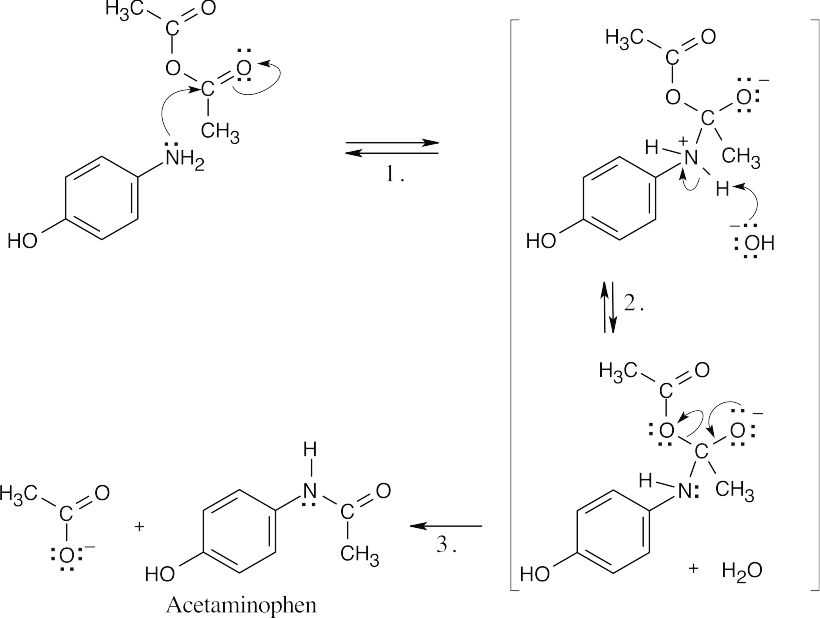 |
|
| Step 1: | Nucleophilic addition of p-hydroxyaniline. | |
| Step 2: | Deprotonation by hydroxide. | |
| Step 3: | Loss of acetate ion. | |
| 11.23 | 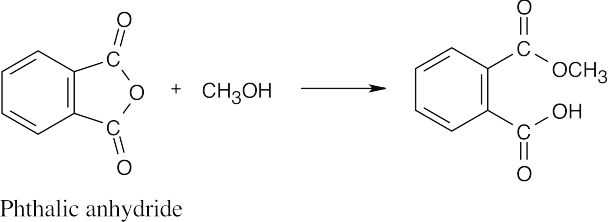
The second half of the anhydride becomes a carboxylic acid. |
| 11.24 | Acidic hydrolysis of an ester is a reversible reaction because the products are an alcohol and a carboxylic acid. Basic hydrolysis of an ester is irreversible because its products are an alcohol and a carboxylate anion, which has a negative charge and does not react with nucleophiles. |
| 11.25 |  |
| 11.26 | Lithium aluminum hydride reduces an ester to form two alcohols. | |||
| (a) |  |
|||
| (b) |  |
|||
| 11.27 | Remember that Grignard reagents can only be used with esters to form a tertiary alcohol that has two identical substituents. Identify these two substituents, which come from the Grignard reagent, and work backward to select the ester (the alkyl group of the ester is unimportant).
|
| 11.28
(c) |
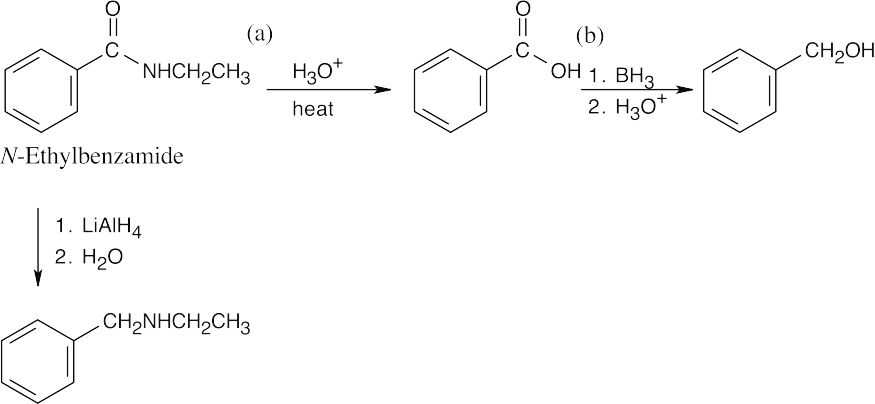 |
| 11.29 |
|
| 11.30 |
Once you realize that the product results from a Grignard reaction with a nitrile, this synthesis is easy. |
| 11.31 | Even though the entire molecule of coenzyme A is biologically important, we are concerned in this problem only with the –SH group. The remainder of the structure is represented here as “R”.
|
|
| Step 1: | Nucleophilic addition of the –SR group of CoA (after deprotonation) to acetyl adenylate to form a tetrahedral intermediate. | |
| Step 2: | Loss of adenosine monophosphate. | |
| 11.32 | In each example, if n molecules of one component react with n molecules of the other component, a polymer with n repeating units is formed, and 2n small molecules are formed as byproducts; these are shown in each reaction. | |||
| (a) |  |
|||
| (b) |  |
|||
| (c) |  |
|||
| 11.33 | 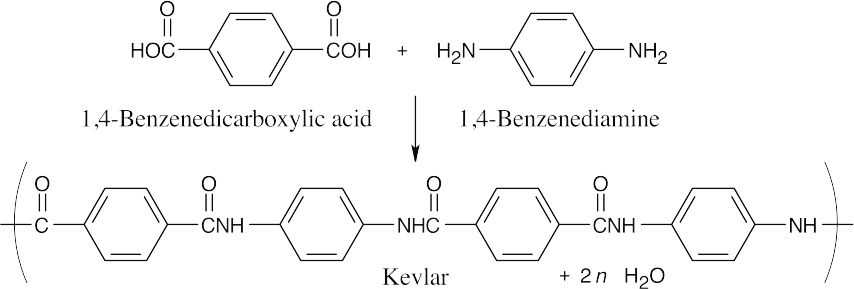 |
Additional Problems
Visualizing Chemistry
| 11.34 |
|
| 11.35 |
(a) p-Bromobenzoic acid is more acidic than benzoic acid because the electron-withdrawing bromine stabilizes the carboxylate anion. (b) This p-substituted aminobenzoic acid is less acidic than benzoic acid because the electron-donating group destabilizes the carboxylate anion. |
| 11.36 |
Nitrile hydrolysis can’t be used to synthesize the above carboxylic acid because the tertiary halide precursor (shown on the right) doesn’t undergo SN2 substitution with cyanide. Grignard carboxylation also can’t be used because the acidic hydroxyl hydrogen interferes with formation of the Grignard reagent. If the hydroxyl group is protected, however, Grignard carboxylation can take place. |
| 11.37 | The electrostatic potential maps show that the aromatic ring of anisole is more electron-rich (red) than the aromatic ring of thioanisole, indicating that the methoxyl group is more strongly electron-donating than the methylthio group. Since electron-donating groups decrease acidity, p-(methylthio)benzoic acid is likely to be a stronger acid than p-methoxybenzoic acid. |
Mechanism Problems
| 11.38 |
|
| 11.39 |
|
| 11.40 |
|
Naming Carboxylic Acids and Nitriles
| 11.41 |
|
| 11.42 |
|
| 11.43 |
|
| 11.44 |
|
| 11.45 |
|
Acidity of Carboxylic Acids
| 11.46 | Less acidic ———-> More acidic
|
| 11.47 | Remember that the conjugate base of a weak acid is a strong base. In other words, the stronger the acid, the weaker the base derived from that acid.
Less basic —————> More basic
|
| 11.48 |
|
| 11.49 |
|
| 11.50 | Inductive effects of functional groups are transmitted through σ bonds. For oxalic acid, the electron-withdrawing inductive effect of one carboxylic acid group decreases the acidity of the remaining group. However, as the length of the carbon chain increases, the effect of one functional group on another decreases. In this example, the influence of the second carboxylic acid group on the ionization of the first is barely felt by succinic and adipic acids. |
Reactions of Carboxylic Acids and Nitriles
| 11.51 | 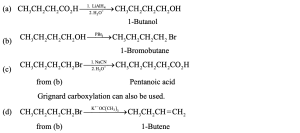 |
| 11.52 |  |
| 11.53 |
|
| 11.54 |
|
| 11.55 | 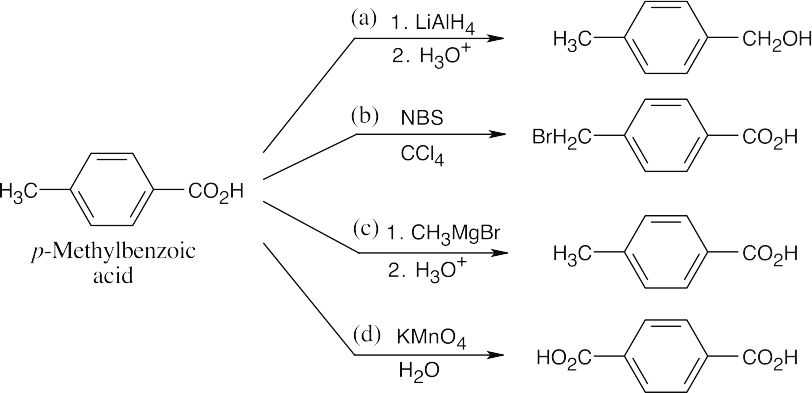
In (c), the acidic proton reacts with the Grignard reagent to form methane, for no net reaction. |
| 11.56 |
|
General Problems
| 11.57 | 2-Chloro-2-methylpentane is a tertiary alkyl halide and –CN is a base. Instead of the desired SN2 reaction of cyanide with a halide, E2 elimination occurs and yields 2-methyl-2-pentene.
|
| 11.58 |
|
| 11.59 | As we have seen throughout this book, the influence of substituents on reactions can be due to inductive effects and/or resonance effects. For m-hydroxybenzoic acid, the negative charge of the carboxylate anion is stabilized by the electron-withdrawing inductive effect of –OH, making this isomer more acidic. For p-hydroxybenzoic acid, the negative charge of the anion is destabilized by the electron-donating resonance effect of –OH that acts over the π electron system of the ring but is not important for m-substituents.
|
Additional Problems
Visualizing Chemistry
| 11.60 | (a) | 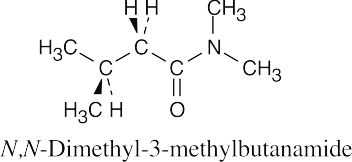 |
(b) | 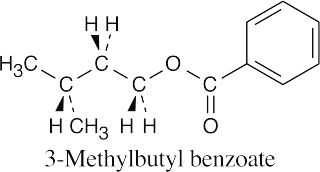 |
| 11.61 | (a) | 
This compound can also be synthesized by Fischer esterification of o-bromobenzoic acid with 2-propanol and an acid catalyst. |
||
| (b) | 
|
|||
| 11.62 | The starting material is 3-methyl-4-pentenoyl chloride, as indicated by the –Cl in the tetrahedral intermediate. Ammonia adds to give the observed tetrahedral intermediate, which eliminates Cl– to yield the above amide. |
| 11.63 | According to the electrostatic potential maps, the carbonyl carbon of acetyl azide is more electron-poor (less red) and therefore more reactive in nucleophilic acyl substitution reactions. Resonance donation of nitrogen lone-pair electrons to the carbonyl group is greater in an amide than in an acyl azide.
|
Mechanism Problems
| 11.64 | (a) | 
Mechanism:
|
| (b) | 
Mechanism:
|
| 11.65 | (a) | 
Mechanism:
|
| (b) | 
Mechanism:
|
| 11.66 | (a) | 
Mechanism:
|
| (b) | 
Mechanism:
|
| 11.67 | (a) | 
Mechanism:
|
| (b) | 
Mechanism:
|
| 11.68 | 
Addition of –OH to the fatty acyl CoA (Step 1), followed by loss of –SCoA from the tetrahedral intermediate (Step 2), produces 1-acylglycerol 3-phosphate. |
| 11.69 | 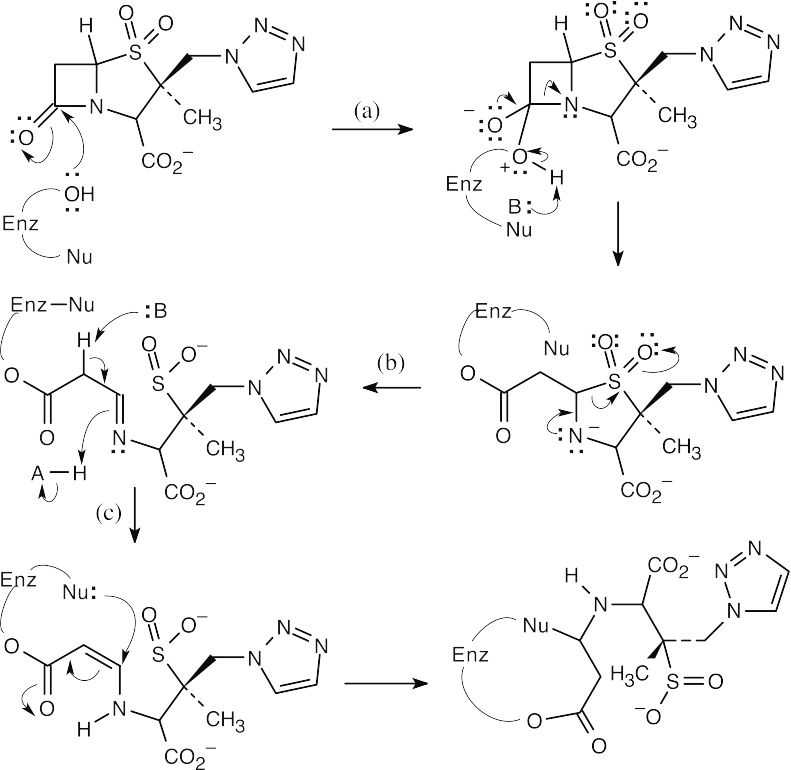
In (c), the imine rearranges to an α,β-unsaturated ester, to which the nucleophile adds to give the trapped β-lactamate. |
| 11.70 | This is a nucleophilic acyl substitution reaction whose mechanism is similar to others we have studied.
I3C:– can act as a leaving group because the electron-withdrawing iodine atoms stabilize the carbanion. |
Naming Carboxylic Acid Derivatives
| 11.71 | (a) | 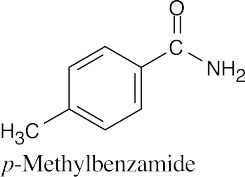 |
(b) | 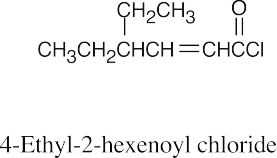 |
| (c) | 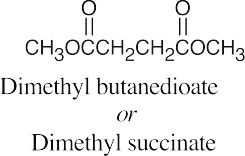 |
(d) | 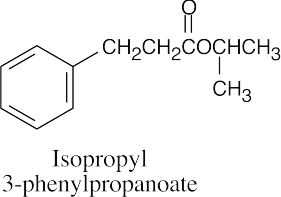 |
|
| (e) | 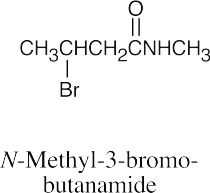 |
(f) | 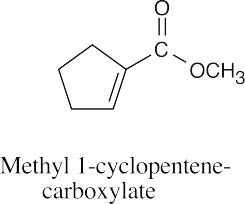 |
|
| (g) | 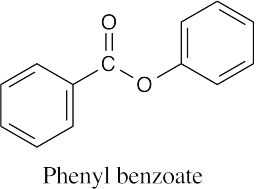 |
(h) | 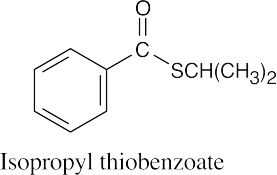 |
| 11.72 | (a) | 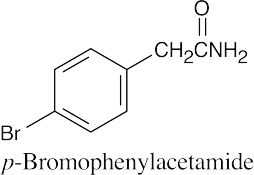 |
(b) | 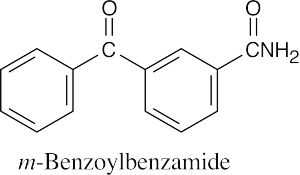 |
| (c) |  |
(d) |  |
|
| (e) | 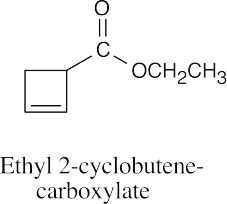 |
(f) | 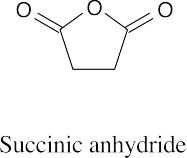 |
| 11.73 | Many structures can be drawn for each part of this problem. | |||
| (a) |  |
|||
| (b) |  |
|||
Nucleophilic Acyl Substitution Reactions
| 11.74 | (a) |  |
||
| (b) |  |
|||
| (c) |  |
|||
| (d) |  |
|||
| (e) |  |
|||
| (f) |  |
|||
| 11.75 | The reagents in parts (d) and (f) don’t react with methyl propanoate. | |||
| (a) |  |
|||
| (b) |  |
|||
| (c) |  |
|||
| (e) |  |
|||
| 11.76 | The reagents in parts (d), (e), and (f) don’t react with propanamide. | |||
| (a)
(b)
(c) |
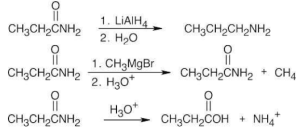 |
|||
| 11.77 | (a) | |||
| (b) | from (a) |
|||
| (c) | from (a) |
|||
| (d) | from (c) |
|||
| (e) | from (c) |
|||
| (f) |  |
|||
| (g) |  |
|||
| (h) |  |
|||
| (i) |  |
|||
| 11.78 | (a) |  |
||
| (b) |  |
|||
| (c) |  |
|||
| (d) |  |
|||
| (e) |  |
|||
| (f) |  |
|||
| (g) |  |
|||
| 11.79 | The reactivity of esters in saponification reactions is influenced by steric factors. Branching in both the acyl and alkyl portions of an ester hinders attack of the hydroxide nucleophile. This effect is less dramatic in the alkyl portion of the ester than in the acyl portion because alkyl branching is one atom farther away from the site of attack, but it is still significant.
|
| 11.80 | 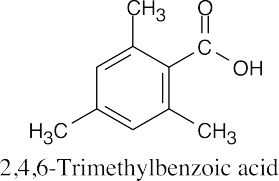
2,4,6-Trimethylbenzoic acid has two methyl groups ortho to the carboxylic acid functional group. These bulky methyl groups block the approach of the alcohol and prevent esterification from occurring under Fischer esterification conditions. A possible route to the methyl ester:
This route succeeds because reaction occurs farther away from the site of steric hindrance. It is also possible to form the acid chloride of 2,4,6-trimethylbenzoic acid and react it with methanol and pyridine. |
| 11.81 | (a) | 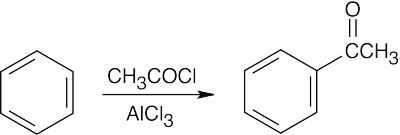 |
||
| (b) |  |
|||
| (c) |  |
|||
| 11.82 | 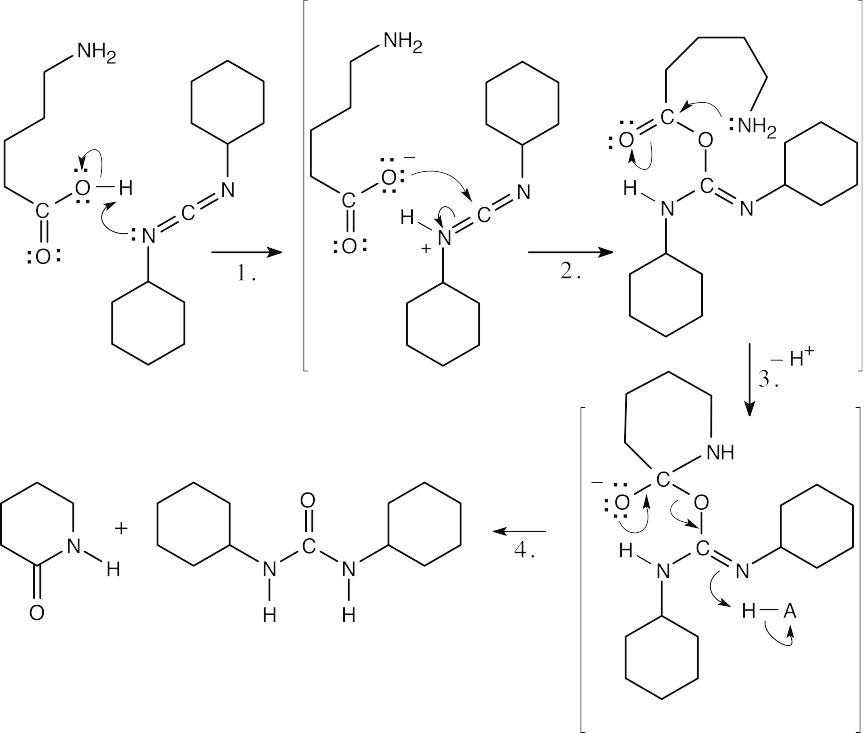 |
|
| Step 1: | The carboxylic acid protonates DCC. | |
| Step 2: | The carboxylate oxygen adds to DCC to form a reactive intermediate. | |
| Step 3: | The amine nitrogen adds to the carbonyl group to yield a tetrahedral intermediate. | |
| Step 4: | The intermediate loses dicyclohexylurea to produce the lactam. | |
| 11.83 | 
This reaction is a typical nucleophilic acyl substitution reaction, with azide as the nucleophile and chloride as the leaving group. |
Step-Growth Polymers
| 11.84 | Look for the monomer units, which are difunctional compounds, in the polymer.
|
| 11.85 | Hydroxide opens the lactone ring, and the resulting anion can add to a second lactone molecule to produce a polyester.
|
| 11.86 | The polyimide pictured is a step-growth polymer of a benzene tetracarboxylic acid and an aromatic diamine.
|
General Problems
| 11.87 | A negatively charged tetrahedral intermediate is formed when the nucleophile –OH attacks the carbonyl carbon of an ester. An electron-withdrawing substituent can stabilize this negatively charged tetrahedral intermediate and increase the rate of reaction. (Contrast this effect with substituent effects in electrophilic aromatic substitution, in which positive charge developed in the intermediate is stabilized by electron-donating substituents.) Substituents that are deactivating in electrophilic aromatic substitution are activating in ester hydrolysis, as the observed reactivity order shows. The substituents –CN and –CHO are electron-withdrawing; –NH2 is strongly electron-donating. | |||
| Most reactive ⎯⎯⎯⎯⎯⎯⎯⎯⎯⎯⎯⎯⎯⎯⎯⎯⎯⎯⎯⎯⎯⎯→ Least reactive
Y = NO2 > CN > CHO > Br > H > CH3 > OCH3 > NH2 |
||||
| 11.88 | (a) | 
Resonance forms show that the carbon of diazomethane is basic, and reaction with an acid can occur to form a methyldiazonium ion.
|
||
| (b) | 
An SN2 reaction takes place in which the carboxylate ion displaces N2 as the leaving group to form the methyl ester. |
|||
| 11.89 | Note: The final step in the formation of an amide in each case is deprotonation. The amine that serves as the nucleophile in the reaction will also react as a base and form an unreactive ammonium salt. If a base strong enough to deprotonate the ammonium salt is present, then the amine will be deprotonated and free to react as a nucleophile. The pKa of an ammonium ion is approximately 10. For an acid chloride, the chloride ion is not a strong enough base to deprotonate an ammonium ion (the pKa of HCl is –5), so a second mole of base is needed to complete the reaction. In the case of an ester, an alkoxide leaving group is generated. An alkoxide is a strong enough base to deprotonate an ammonium ion (the pKa of an alcohol is approximately 16). Thus, the reaction does not require any additional base.
|





